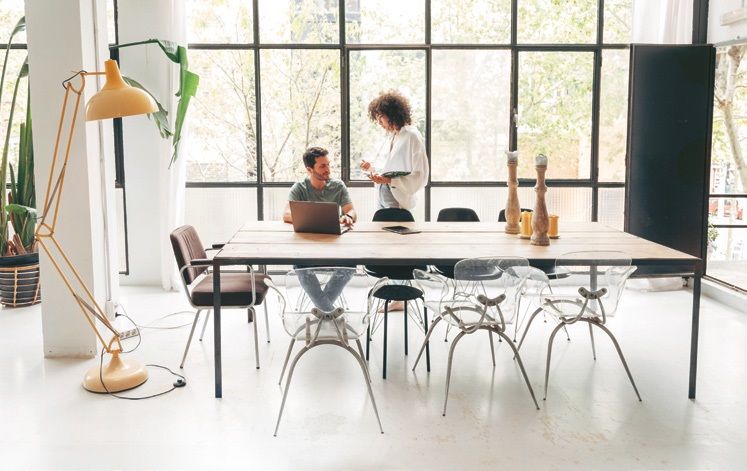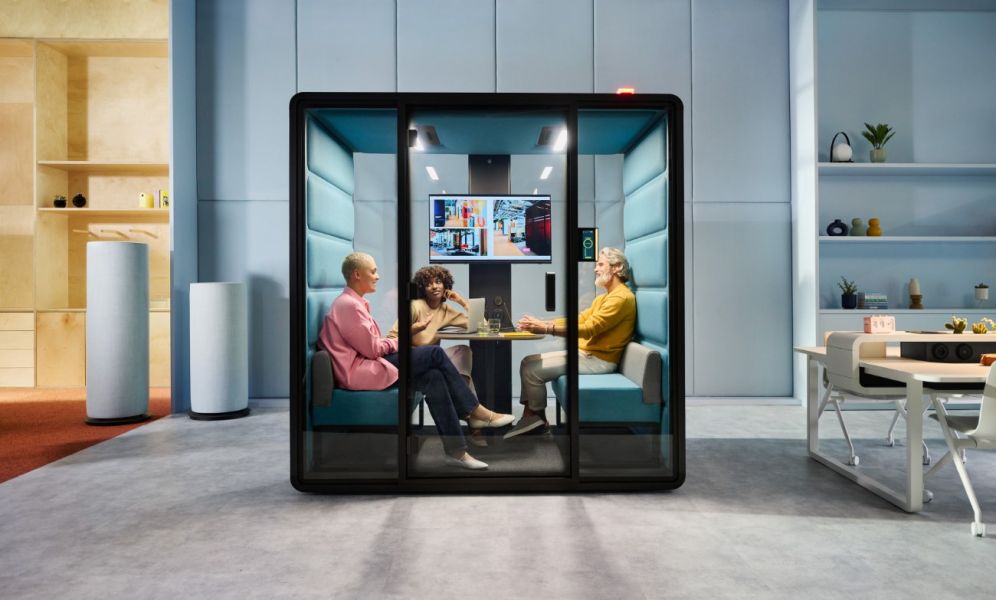Employee needs define the “office of the future”

The landscape of office work has redefined the needs and expectations of employees in a reality that has adopted the hybrid work model as standard. A contemporary employee uses the office with a new set of 'needs 4.0'. Today, one of the most desirable features of the office is the freedom to choose where to work and how to work.
A flexible office is now a determinant of effective business development, both in terms of architectural design and equipment. Our thinking about the office of the future is an all-encompassing one. We start with the environment in which the property itself is located and the infrastructure it is equipped with. A key element is the security and automation of the technology within it. The ability to provide employees with flexible office space that can be quickly reconfigured on demand without the need for construction and installation work is fundamental today.
Mobile workplaces are becoming an everyday reality. Traffic routes with the possibility of introducing one-way traffic at office level, contactless sanitary installations, intelligent control systems for ventilation, air conditioning and heating, and access control systems combined with applications for organising and managing meetings are all gaining in popularity.
An eco-building is also an eco- and energy-efficient office. It is metered and certified to standards. It is estimated that nearly 60-70% of an office building’s maintenance costs are related to its operation. Consequently, its operation – i.e. the office space itself – also needs to be more environmentally friendly.
Employees and their needs
The human being, the employee, is the most important element in designing the office of the future. Meeting their physical and mental needs at work is key. This ranges from an acoustically comfortable workspace with separate areas for quiet and conceptual work, equipped with functional acoustic pods for work and meetings, to flexible teamwork solutions that adapt to the changing number of people in the office and the tasks being performed, to a modern infrastructure that offers the possibility of working online with videoconferencing systems, including the possibility of conducting online training and webinars.
Innovative solutions based on the most advanced applications, designed to adapt the conditions of the space to the needs and preferences of the users, will facilitate communication with others, synchronise data and save time through advanced automation and digitisation. Software tailored to the organisation at the level of artificial intelligence – informing employees about the weather, current company activities and news – will become part of everyday life.
We increasingly start the day choosing where to work: home, office or public space. Before long, we will be confirming this choice in an office management app. Tomorrow’s technology will define the way we work and the solutions we use. Offices are places where smart technologies based on AI, IoT, VR, AR, beacons and biometrics, platforms or apps, among others, will facilitate not only work but also office functioning.
Designers point to desks and workstations with virtual keyboards and intelligent voice and video conferencing systems hidden in furniture systems as the next step. Modern mix-and-match furniture systems are more and more frequently selected for working and meeting. The correct division of the office into different work zones is key to avoiding the negative effects of the modern employee’s overstimulation and providing a comfortable acoustic workspace that guarantees privacy and confidentiality of conversations.
Hybrid and flexible
Employee autonomy is very important today. First and foremost, this applies to the way they work – whether they work remotely or in the office. More than 63% of employees report that they have a hybrid work model, which is a combination of remote work and office work[1]. More than 57% confirm that they use the office 1-3 days a week[2]. We are most likely to work in the office from Tuesday to Thursday and to work remotely on Fridays and Mondays. The office should be flexible, meaning that it should be able to cope with varying number of employees. It also needs to provide connectivity and access to systems for remote workers.
All you can be sure of is change
Today, no one has the full picture of what the future office will look like in five or ten years’ time. All that is certain is that it will change. Consequently, the most sought-after skill for employees is the ability to adapt to our changing environment and to become lifelong learners. Resilience includes the skill of coping with stress, the flexibility to accept change, and being able to deal with new and surprising situations as well to cope with unpredictability and instability. High levels of resilience in employees are desirable. It is already one of the most in-demand skills of tomorrow, and the office infrastructure of the future will have to keep up.
Flexible workplace solution
The constant feature of the modern office is the changing number of individuals who use it every day. This trend will only increase in the future. Plenty of factors, largely related to the specific nature of a particular industry or location, can cause the percentage of standard office occupancy to vary. An analysis of data from New York’s Manhattan suggests that the average office occupancy rate today is between 55% and 60% of all employees[3].
As a result, the cornerstone of the modern office space is becoming a flexible workspace that allows people to perform tasks in comfort, regardless of the nature of the task – whether it is large group meetings, video conferencing, or assignments that the staff members have to focus on in a quiet and peaceful setting. Employees who need to concentrate will benefit from acoustic solutions for focused work, such as acoustic office booths. They will also appreciate workstations in an area of the office that is free from conversations and office noise.
If you are looking for a flexible workspace arrangement, hot desking is a good solution. Multi-workstation desks or a bench-type desk arrangement that is not assigned to a specific person allows employees to choose a workstation according to their needs. This makes it easier for clusters of people with similar working styles to form in certain office spaces on any given day. Those who need isolation and concentration are not tied to a single desk in a noisy environment.
Flexibility as a factor in company growth
The market research is clear: organisations that have adopted a flexible ap proach to how and where their employees work experience significantly higher revenue growth: +21% over two years compared to +5% growth for organisations that have not fully embraced flexible working4. This trend is set to continue. These pro-flexibility organisations can also see increases in customer satisfaction, volume of innovative solutions, or productivity in manufacturing or provision of services. However, the businesses that have been surveyed focus not only on implementation, but also on building the right organisational culture, on training their managers and on introducing tools to facilitate flexible work – the outcome is that these companies promote employee satisfaction and engagement.
Wellbeing in the technical details
The most irritating and distracting aspect of an open office is excessive noise. Half of employees say they would feel more productive in a less noisy working environment[5]. Unfortunately, 64% of employees feel disturbed by noise from conversations and phone calls[6].
The solution to this problem lies in a range of acoustic solutions for the office: in-office walls that also divide the space, wall and ceiling acoustic materials, stand-alone acoustic booths for quiet and focused work (individually or in groups). The latter, which also offer adjustable lighting or ventilation, allow the working conditions to be further adapted to the individual expectations and preferences of their users. The mobility of such solutions is a good match for the flexible office concept: an acoustic booth can be moved around the office without the need for any renovation work.
The mobility of such solutions is a good match for the flexible office concept: an acoustic booth can be moved around the office without the need for any renovation work. Cosy, home-like office spaces (with modern ergonomic office furniture, flexible solutions for working alone as well as for larger project teams) are now the standard – and all of this alongside spaces designed for rest and short breaks. Today’s offices should, and increasingly do, meet the needs of people with disabilities or neurodivergent individuals.
[1] “Hybrid Ways of Working 2022 Global Report”, Jabra.
[2] Report on the office use opinion survey “Zaprojektuj biuro przyszłości”, Skanska & Colliers.
[3] “The future of work office buildings and American downtowns”, Forbes.
[4] “The Flex Report 2024”, Flex Index presented by Scoop.
[5] “Workplace Trends 2023 & Transformation Strategies”, Haworth.
[6] Report on the office use opinion survey “Zaprojektuj biuro przyszłości”, Skanska & Colliers.
Author: Mateusz Barczyk, Senior Brand Manager, Hushoffice
This article comes from magazine:
FOCUS ON Business #15 March-April (2/2024)
 Check the issue
Check the issue








